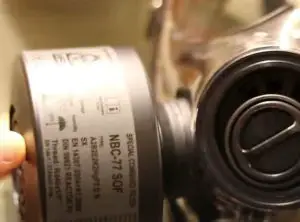In the world of respirators, one type stands out as being capable of protecting the wearer from the most extreme airborne threats. This is the CBRN respirator, which also includes a filter. Keep reading to find out more about how it works and how it can protect you.
What does a CBRN filter protect against?
A CBRN filter is a device that helps protect individuals from Chemical, Biological, Radiological, and Nuclear (CBRN) threats. These filters are typically used in conjunction with full-face respirators or powered air-purifying respirators (PAPRs).
The CBRN APR protects against 110 chemical gases, vapors, and solid/liquid chemical aerosols classified by the NIOSH/U.S. Army RDECOM threat assessments as probable CBRN agents.
How long does a CBRN filter last?
A 20-year shelf life is provided. This includes all 40mm NATO respirators. All known CBRN agents may be filtered out.
Will P100 filter tear gas?
Respirator masks such as the N95 or P100 varieties, which are commonly available, provide the bare minimum level of protection in most emergency situations, including tear gas. Floating charred plant and building fragments, dust, and microorganisms are all removed by these filters. Disposable respirator masks, on the other hand, cannot shield against gases and vapors.
Related Questions and Answers
What are CBRN filters made of?
A CBRN APER consists of a hood that is fitted over the whole head and a filter that is connected to the hood. The hood shields the wearer’s head and eyes from the elements using a synthetic rubber construction.
Are gas mask filters universal?
The kinds of gas mask filters vary by gas mask category and the nature of the gases or vapors they are intended to contain. The EN 14687 European standard mandates that each respirator cartridge be identified with a letter and a specified color for each gas or gas family.
Is it safe to use an expired gas mask filter?
You will not be covered if the mask’s filter cartridges are old, exposed to the air, or broken. Carriers with charcoal or other air-purifying chemicals should be packaged in airtight containers. Unless the cartridges are sealed in airtight packing, they should be avoided.
What mask protects from chemical and biological agents?
A CBRN respirator can protect from chemical or biological agents.
What is the main disadvantage of negative pressure respirators?
Negative-pressure respirators have a major drawback in that contaminated air may be drawn into the facepiece via a leak in the system (e.g., a break in the hose or an ill-fitting mask or facepiece).
What type of gas mask does the US military use?
The M40 field mask.
How do I prep a gas mask?
This video should help:
What should I look for when buying a gas mask?
Masks that guard against CBRN pollutants should be on your shopping list for emergency preparedness. This can include chemicals, nerve agents, poisonous gases, and toxic compounds. Also to look out for is protection from biological threats such as bacteria, viruses, and fungus. Radiological threats can occur in war zones, such as from a dirty bomb that releases radioactive particles into the environment.
Were gas masks used in ww2?
In the event that the Germans landed poison gas bombs on Britain, the British government issued gas masks to everyone, even newborns, in 1938.
Do P100 filters expire?
They will survive for five years if kept in their original packaging and unopened.
Do gas masks filter radiation?
Protective masks (i.e., air purified respirators) provide good protection against radioactive material inhalation. Tritium gas and radon gas may flow through these filters, as well. Medically speaking, short-term exposure to these gases is not considered harmful.
Can you reuse an N95 mask?
If an N95 respirator is not dusty, broken, or difficult to breathe through, it may be reused. Before each usage, examine your respirator.
Does N95 protect against paint fumes?
Spray painting requires the use of a respirator. What is the best one? Disposable paper masks with two straps, such as the N95 particulate filtering respirators, are an inexpensive alternative that perform an excellent job of filtering out airborne particles. However, the problem is that they do not absorb harmful gasses.
Does N95 protect against carbon monoxide?
All three types of masks, such as surgical masks, N95 masks, and carbon masks, were helpful in reducing CO levels due to air pollution, with N95 and carbon masks being the most significant. Fabric masks provide the least protection against high concentrations of carbon monoxide.
Do gas masks protect against ammonia?
Yes. You can protect yourself from the dangers of phosphine, ammonia, and chlorine with a gas mask and canister. Particulate aerosols are effectively blocked by a P100 Particulate Filter (99.97% filter effectiveness level).
Is a dust mask negative pressure?
Mechanical filters and chemical media are the primary components of a negative-pressure respirator. If sealed, dust masks may also serve as negative-pressure respirators.
In which environment should you never use an air-purifying respirator?
Oxygen isn’t provided by air-purifying respirators. The risk of asphyxiation is high if you use it in a low-oxygen setting like a fire or confined area.
Conclusion
CBRN filters are designed to filter the air that has been contaminated by the most dangerous air-borne threats, such as viruses and radiation leaks. However, if you expect to be in an environment where CBRN threats are a possibility, make sure your respirator and filter can handle them.
CBRN stands for “Chemical, Biological, Radiological, Nuclear.” The purpose of a CBRN filter is to protect individuals from the effects of these types of weapons. A CBRN filter can be worn on a gas mask or as a separate piece of equipment.
NEXT UP: What Is a CBRN Emergency?
Related Tags
- mira cbrn filter
- cbrn filter 3m
- scott cbrn filter
- 3m ™ canister fr-15-cbrn
- nbc-77 sof filter

